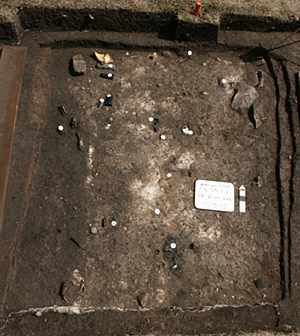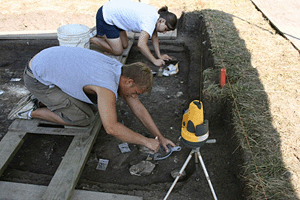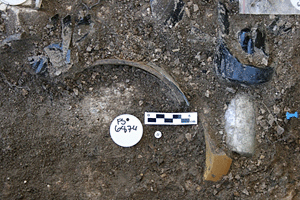
The final shot of Level 2 of the 1863 hospital latrine
Over the last week, we began excavating the third level of the hospital latrine, bringing the latrine down to about 12 cm below the plow zone (actually to 61-64 cm below temporary datum!). At this depth, we are finally breaking through the clay that was placed on top of the waste to seal it. We also came across significant quantities of odor-reducing lime. After being covered with clay and lime, the artifacts below have remained undisturbed until today. While everyone is initially disgusted by the idea that we are working in a latrine, sanitation is not an issue because human waste decomposes into rich soil over time.

Sweeping the floor of the latrine. Students Dave Walton (Wooster College) and Theresa Kalka (incoming first-year student at Heidelberg College).
We uncovered many artifacts that reveal clues about the prisoners’ lifestyles. For instance, we found numerous eggshell pieces and chicken bones, suggesting that poultry was a significant component of the hospital diet. Other remains and artifacts include animal bones, unidentified iron metal fragments, newspaper scraps, ceramics, bottles, minié balls, and buttons (bone, Prosser, shell, iron, and copper). The bottles and animal bones were probably thrown in as trash, while buttons, toothbrushes, and silverware may have been lost from accidental drops and loose pockets. Since we came across things that we did not expect to find in a latrine, our dig will not only provide information about the prisoners’ diet and health, but also about their entertainment, clothing, privileges, and contraband materials.
We will also be able to assign exact dates to our extrapolations about prison culture. Fortunately, the latrines at Johnson’s Island are all specifically dated, unlike any other prison in the United States. This means that we can date the latrine, as well as the artifacts from it. The saying that you can tell about someone’s life through his or her trash really does apply to this excavation.

FS 6874 is a shell button that was found with another yellow-ware chamber pot, medicine bottle, and two clusters of glass (probable ale bottles).
Inside the “weather port,” we are still working on a couple of features related to Block 6 itself. Several possible postholes have turned out to be root and rodent disturbances, while the real ones are in both nice square and circular shapes, usually containing pieces of mortar. In a larger feature, we found discolored soil and remnants of charcoal–evidence of a fire. We also discovered beautiful flint flakes and even a Native American projectile point fragment. However, we have yet to conclude exactly what this feature may be.
Even though we are finished with the field school, we are looking forward to the next reports in the Interactive Dig to see what else is discovered at Johnson’s Island. We all agree that this has been a very rewarding learning experience.
![[image]](https://interactive.archaeology.org/johnsons/gifs/07field29.gif) |
The Field Crew posing by the latrine. Level 2 has just been completed, mapped and photographed. |

![[image]](https://interactive.archaeology.org/johnsons/gifs/07field26.gif)
![[image]](https://interactive.archaeology.org/johnsons/gifs/07field27.gif)
![[image]](https://interactive.archaeology.org/johnsons/gifs/07field28.gif)
![[image]](https://interactive.archaeology.org/johnsons/gifs/07field33.gif)
